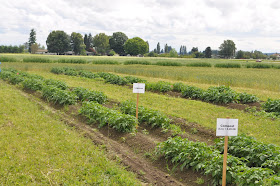I am not the only one who thinks that growing grains and forage is a good idea. I'd guess that this field session was attended by about 400 people. They had samples from their bread lab, which I'll take about in another post. The bread lab is cool all by itself.
For the presentation they'd labeled each grain, so you could clearly see the characteristics of each type. They had 42,000. (Forty two THOUSAND) types of grain growing at this facility this year.
Forty thousand types of grain. Who knew?
The tag on the right is particularly interesting to me. So land about 20 miles away from me, in the same sort of soil and with the same weather patterns, produced over 3 tons of grain per acre. 3 tons of grain would feed a sow and piglets for roughly 2 years. This sort of number gives me an idea of how many acres I'd have to devote to grow all of the feed for my pigs. Yes, you nutritionists out there, I'm ignoring the fact that it's really, really hard to grow protein in vegetable form around here.
This is a potato experiment that is looking at the effect of crop rotation and compost and standard fertilizer on potato yields. They're also looking at biosolids (treated sewage by-product) to see how it grows crops. Not a big fan of biosolids, but that's what manure is, too.
This variety of grain was both high-yielding and was voted as best tasting.
Andrew Corbin is a researcher who planted alfalfa in the fall of last year, 7 varieties and has been tracking growth and production since. he's standing in his alfalfa field which has already had a first cutting and is about to be cut for a second time. This is REALLY exciting to me, as alfalfa is the single largest expense when you're forage feeding dairy cows. I was really glad to see his presentation, and its given me 7 varieties to choose from for my own field tests.
The handout that Andrew had prepared has several graphs of yields, growth, plant date, tested forage values and so on for each type of alfalfa. I'm looking for a seeder now and looking forward to trying some alfalfa of my own!














Sulfur and Potassium are key players for alfalfa. Also you'll probably need to reseed every 2-3 years, unless you let it so self seed, but that pretty much pulls that pasture out of rotation.
ReplyDeleteWe grow a lot of alfalfa here on the east coast (I'm in MD now), so I'm looking forward to how things go for you. We're starting our 3rd cutting tomorrow :)
Sulfur and Potassium are key players for alfalfa. Also you'll probably need to reseed every 2-3 years, unless you let it so self seed, but that pretty much pulls that pasture out of rotation. It also does well (IMO) with orchard grass, especially to minimize grass fever in the springtime.
ReplyDeleteWe grow a lot of alfalfa here on the east coast (I'm in MD now), so I'm looking forward to how things go for you. We're starting our 3rd cutting tomorrow :)
You may want to consider mixing some brome with your alfalfa. It will grow better in the first year after seeding and helps keep the weeds down as well. We also find it is a nice mix for the cattle as well.
ReplyDeleteYou might want to consider adding brome to your alfalfa when you seed. It will come in better in the first year after seeding, helps keep weeds out, and we find it to be a nice mix for the cattle.
ReplyDeleteGood luck.